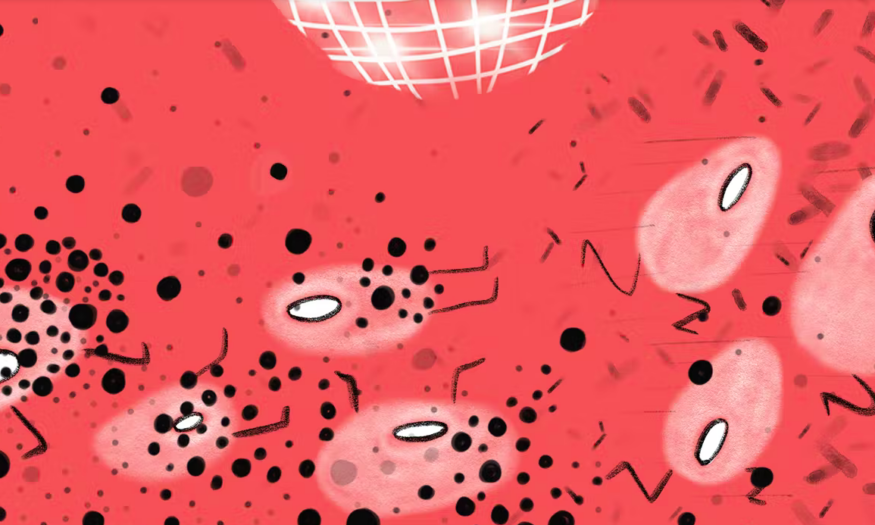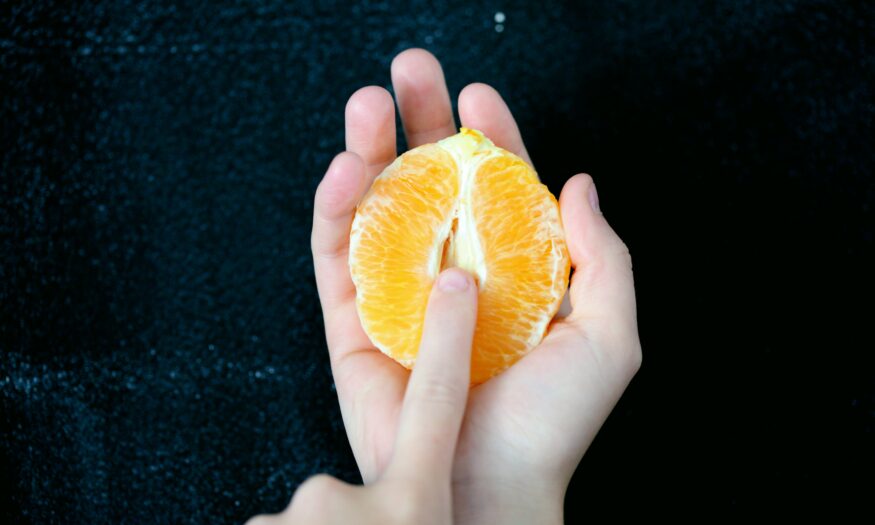Self-Exam: Vulva and Vagina
 Photo courtesy of Assiouar Association
Photo courtesy of Assiouar Association
Edited by Our Bodies Ourselves Today Sexuality Content Experts, July 2022
This content is adapted from an earlier article by Our Bodies Ourselves Anatomy & Menstruation Contributors.
This article looks at the structure (anatomy) and function (physiology) of the vulva and vagina.
The appearance, shape, size, particular arrangement and even the proportions of genitals vary from person to person as much as the shape and size of other body parts. There is a wide range that is considered normal, and what is described here is just what is the most common. Some of what is described may or may not be an accurate description of your body or its parts. For example, if you’re intersex, or if you’ve experienced female genital cutting and/or other kinds of sexual trauma, your genitals may look and feel different than this description. Regardless, becoming familiar with your own body can help you to learn what is normal for you.
The following descriptions will be much clearer if you look at your genitals with a hand mirror while you read the text. Make sure you have enough time and privacy to feel relaxed. Try squatting on the floor and putting the mirror between your feet.
If you’re uncomfortable in that position, sit as far forward on the edge of a chair as you comfortably can, separate your legs, and place the mirror between them. If you’re having a hard time seeing, try aiming a flashlight at your genitals or at the mirror.
Vulva
First, you will see your vulva — all the external organs you can see outside your body. The vulva includes the mons pubis (Latin for “pubic mound”), labia majora (outer lips), labia minora (inner lips), the external portions of the clitoris, and the external openings of the urethra and vagina.
People often confuse the vulva with the vagina. The vagina, also known as the birth canal, is inside your body. Only the opening of the vagina (introitus) can be seen from the outside, and even then only if you spread your legs wide apart.
Unless you shave or wax around your vulva, the most obvious feature is often the pubic hair, the first wisps of which are one of the early signs of puberty. After menopause, the hair thins out.
Mon, or Mons Pubis
Pubic hair usually covers the soft fatty tissue called the mons (also mons veneris, mound of Venus, or mons pubis). The mons lies over the pubic symphysis. This is the joint of the pubic bones, which are part of the pelvis, or hip girdle. You can feel the pubic bones beneath the mons pubis.
As you spread your legs, you may see in the mirror that the hair continues between your legs and probably around your anus. The anus is the outside opening of the rectum (the end of the large intestine, or colon).
Labia Majora and Labia Minora
The fatty tissue of the mons pubis also continues between your legs to form two labia majora, the outer lips of the vulva. The hair-covered labia majora are also fatty, and their size, color and shape differ considerably among people.
The labia majora surround the labia minora (the inner lips of the vulva). For some people, the labia minora – which means “small” or “less” in Latin–are actually the larger set of lips. The labia minora are hairless and very sensitive to touch. Gently spread apart the inner lips, and you’ll see that they protect a delicate area between them. This is the vestibule.
Glans and Clitoris
Right below the mons, the inner lips join to form a soft fold of skin, or hood, over and covering the glans, or tip of the clitoris.
Gently pull up the hood to view the glans. The glans is the spot most sensitive to sexual stimulation. Many people confuse the glans with the entire clitoris, but it is simply the most visible part.
Did you know the clitoris is identical in origin, and similar in function, to the penis? All reproductive organs are developed from the same embryonic tissue. In fact, the reproductive organs of most fetuses are identical during the first six weeks of development. The glans of the clitoris corresponds to the glans of the penis, and the labia majora correspond to the scrotum.
Clitoris Shaft
Let the hood slide back. Extending from the hood up to the pubic symphysis, you can now feel a hardish, rubbery, movable rod right under the skin. It is sometimes sexually stimulating when touched. This is the body or shaft of the clitoris. It is connected to the bone by a suspensory ligament. You cannot feel this ligament or the next few organs described, but they may play a role in sexual arousal and orgasm.
At the point where you no longer feel the shaft of the clitoris, it divides into two parts, spreading out wishbone fashion but at a much wider angle, to form the crura (singular: crus), the two anchoring wing tips of erectile tissue that attach to the pelvic bones. The crura of the clitoris are about three inches long.
Vestibular Bulbs
Starting from where the shaft and crura meet, and continuing down along the sides of the vestibule, are two bundles of erectile tissue called the bulbs of the vestibule. The bulbs, along with the whole clitoris (glans, shaft, crura), become firm and filled with blood during sexual arousal, as do the walls of the vagina.
Both the crura of the clitoris and the bulbs of the vestibule are covered in muscle tissue. This muscle helps to create tension and fullness during arousal and contracts during orgasm, playing an important role in the involuntary spasms felt at that time. It’s suspected that the clitoris and vestibular bulbs are the only organs in the body with the sole purpose of sexual pleasure and arousal. However, so little research has been done that we don’t actually know what other roles the clitoris and vestibular bulbs may play in our bodies.
Greater Vestibular Glands
The greater vestibular glands (also known as Bartholin’s glands) are two small rounded bodies on either side of the vaginal opening near the bottom of the vestibule. They secrete a small amount of fluid during arousal. Usually you cannot see or feel them.
Periurethral Glands
You can’t see your periurethral glands, since they branch off the walls of the urethra, but they are worth knowing about. The periurethral glands (also known as Skene’s glands) lubricate the urethra to help prevent irritation and urinary tract infections. And, it’s hypothesized that they produce the fluid for vulvar ejaculation (squirting).
Urinary Opening
If you keep the inner lips spread and pull the hood of the clitoris back again, you will notice that the inner lips attach to the underside of the clitoris. Right below this attachment you will see a small dot or slit. This is the urinary opening, the outer opening of the urethra, a short (about an inch and a half), thin tube leading to your bladder.
Vaginal Opening and Hymen
Below the opening of the urethra is the vaginal opening (introitus). Around the vaginal opening you may be able to see the remains of the hymen, also known as the vaginal corona. This is a thin membrane just inside the vaginal opening, partially blocking the opening but almost never covering it completely.
Vaginal coronas come in widely varying sizes and shapes. For most of us, they stretch easily after puberty—with insertion of a tampon, a finger, a penis, or a dildo. Even after the hymen has been stretched, little folds of tissue generally remain.
Walls of the Vagina
If you’re comfortable doing so, slowly put a clean finger or two inside your vagina. If it hurts or you have trouble, take a deep breath and relax. You may be pushing at an awkward angle, your vagina may be dry, or you may be unconsciously tensing the muscles owing to fear of discomfort. Try shifting positions and using a lubricant (don’t use a perfumed oil or lotion that could cause irritation).
If it’s still uncomfortable, you don’t need to go any further. If you find that gently touching your own vagina remains painful, you should talk to a health care provider who specializes in pelvic pain. Regardless of the cause of your vaginal pain, or how long you’ve had it, you deserve to find relief and experience vaginal pleasure if you wish.
Notice how the vaginal walls, which were touching each other, spread around and hug your fingers. Feel the soft folds of mucous membrane. These folds allow the vagina to stretch and to mold itself around whatever is inside, including fingers, a tampon, a penis, or a baby during childbirth.
The walls of the vagina may vary from almost dry to very wet. The vagina is likely to be drier before puberty, during breastfeeding, and after menopause, as well as during that part of the menstrual cycle right before and after the flow. It’s likely to be wetter around ovulation, during pregnancy, and during sexual arousal.
Push gently against the walls of the vagina, and notice where the walls feel particularly sensitive to touch. This sensitivity may occur only in the area closest to the vaginal opening, or in most or all of the vagina.
Only a thin wall of mucous membrane and connective tissue separates the vagina from the rectum, so you may be able to feel bumps on the side of your vagina closest to your spine if you have some stool in the rectum.
Normal/Not Normal
Vaginal and cervical fluid (discharge) are normal. However, any of the following may indicate an infection or another problem. Contact a healthcare provider if you experience:
- Green, gray, or dark yellow discharge
- Significant change in the amount or consistency of discharge
- A strong odor unusual for you
- Foamy discharge
The G-Spot
About a third of the way up from the vaginal opening, on the anterior (front) wall of the vagina (the side toward your abdomen), is an area known as the Gräfenberg spot, or G-spot. Many people experience intensely pleasurable sensations when this area is stimulated. There are differences of opinion over whether the G-spot is a distinct anatomical structure, part of the internal clitoris or urethral sponge,or whether sensation felt when the area is stimulated is due to its proximity to the bulbs of the clitoris, the urethra, Skene’s glands and other portions of the vaginal anatomy.
Pelvic Contractions
When your finger is halfway in, try to grip it with your vagina. That sensation you feel is a contraction of the pelvic floor muscles. These muscles hold the pelvic organs in place and provide support for your other organs all the way up to your diaphragm, which is stretched across the bottom of your rib cage. Pelvic floor (Kegel) exercises can help to strengthen the pelvic floor muscles and increase sexual pleasure.
Cervix
A little before the end of the vagina you can feel your cervix. The cervix feels like a nose with a small dimple in its center. The cervix (from the Latin cervix uteri, meaning “neck of the womb”) is the part of the uterus or womb that extends into the vagina. It is sensitive to pressure but has no nerve endings on the surface.
The uterus changes position, color and shape during the menstrual cycle, as well as during puberty and menopause, so you may feel the cervix in a different place from one day to the next. Some days you can barely reach it. The vagina also lengthens slightly during sexual arousal, carrying the cervix deeper into the body.
The dimple in the cervix is the os, or opening into the uterus. The entrance is very small. Normally, only menstrual fluid leaving the uterus, or seminal fluid entering the uterus, passes through the cervix. No tampon, finger, or penis can go up through it, although it is capable of expanding enormously for a baby during labor and birth.
Fornix
Slide your middle finger as far back into your vagina as you can. Notice that your finger goes in toward the small of your back at an angle, not straight up the middle of your body. When you are standing, your vagina is at about a 45-degree angle to the floor. With your finger you may be able to just feel the deep end of your vagina, or the fornix. (Not everyone can reach this; it may help if you bring your knees and chest closer together so your finger can slide in farther.)
Related:
To learn how to wash your vulva and vagina, see How to Wash It
For a step-by-step guide on how to see your cervix, see Self-Exam: The Cervix Up Close
We explain what the hymen is and debunk many myths in, What Exactly is a Hymen?






